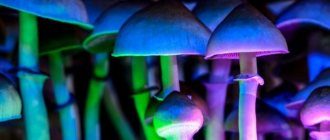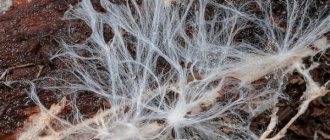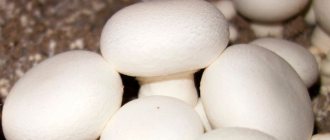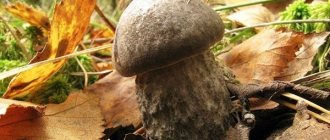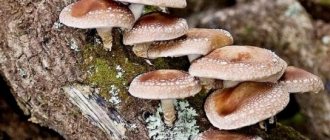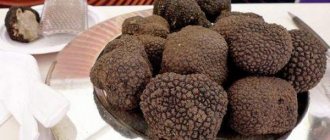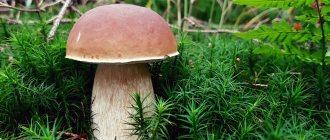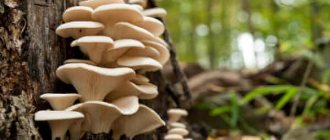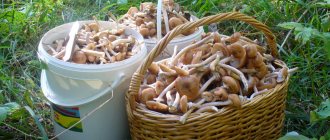Mushrooms
0
1397
Article rating
Kira Stoletova
Mushrooms have long been classified as part of the plant kingdom, so the science of fungi has been part of the botanical sciences. The science of mushrooms is called mycology; as a separate science, it emerged in the 2nd half of the 19th century. The purpose of studying these two areas is to determine the beneficial qualities, possibilities of intended use and toxicity of mushrooms.
Mushroom Science
Subject of study of mycology
Mycology is a science that studies mushrooms in all their diversity. The peculiarity of these living organisms is that they are not able to produce their own food as, for example, plants do. For full growth, they need to find a source of nutrients. They grow well in dark places and do not need light as a source of life. Many types of mushrooms are similar to plants in appearance, but there are also those that are completely different.
Mycology and phytopathology
Phytopathology is a branch of biology and agriculture that studies the development and reproduction of phytopathogens on plants, methods of protection against damage. It is closely related to mycology, since a large number of phytopathogens are identified among mycological objects.
- Author: Maria Sukhorukikh
Rate this article:
- 5
- 4
- 3
- 2
- 1
(0 votes, average: 0 out of 5)
Share with your friends!
The healing power of mushrooms
There are types of mushrooms that are used as medicines to cure various ailments, and the healing properties are so effective that they are considered magical. One of the most striking examples of beneficial mushrooms is penicillin, which over its long history has saved more than one thousand human lives. Penicillin is used as an antibiotic to treat bacterial infections. The mold from which it is extracted prevents the growth of bacteria. Mushrooms are the basis for many types of medicines, such as steroids, which treat different types of diseases.
Mycologists
A mycologist studies diseases caused by fungi. He diagnoses, carries out preventive and therapeutic measures for fungal diseases: different types of lichen. Advanced diagnostic techniques allow you to quickly identify the fungus, determine its nature and origin.
The diseases treated by a mycologist are called mycoses. They can be of several types:
- Dermatomycosis: the pathogen affects the skin and nails.
- Candidiasis: the fungus “occupies” the mucous membranes and tissues of internal organs.
Bad mushrooms
Mycology is the science of mushrooms, and as you know, they can be good and not so good. Fungal infections can cause diseases of the skin, mouth, blood and even the heart. A person may become seriously ill and require medication to get rid of these nasty infections. The fungus can harm not only the human body, but also the home.
Fungi in the form of mold can cover the walls of houses, causing dampness and an unpleasant odor, and the dust from it can cause allergic reactions in people, such as watery eyes and coughing. Many types of mushrooms are poisonous and should not be eaten as they can cause serious poisoning and even death.
What is radical mycology?
Radical mycology is a social movement and social philosophy based on the belief that the highly resilient life cycles of fungi and their interactions in nature serve as powerful teaching tools for how humans can best interact with each other and properly govern the world in which they live. These ideas originated in 2006. Why are mushrooms so important? Radical mycology is the science of how mushrooms can improve the quality of life of the world's population. The world of mycology is constantly expanding, and the practical integration of fungi into modern life is taking on new forms.
The use of the word “radical” to describe this approach to the science and culture of mycology depends on several factors. First, the use of mushrooms serves to improve the environment and is directly related to radical ecology, which recognizes the sacred value of every living being. Secondly, personal, social and environmental sustainability is improved through the use of mushrooms. Third, the word “radical” comes from the Latin “radix,” meaning “root.”
Problems such as lack of food, water, cleanliness, soil fertility, reducing pollution and much more can be solved through targeted work with fungi - the study of mycology. Sometimes getting the most out of science requires literally getting to the bottom of things.
History of the development of mycology
People have been interested in mushrooms and their properties since ancient times, but the beginning of their scientific study dates back to the 4th century BC, when the famous Greek philosopher and scientist Theophrastus first decided to scientifically systematize the types of mushrooms. A century and a half later, the physician Nikander Kolofonsky was the first to scientifically divide forest products into edible and inedible species.
During the heyday of Ancient Rome, a number of scientists paid attention to attempts to classify the types of mushrooms known to them, divide them into edible and inedible groups, and describe in detail some of the species well known to them. Among them are the father of pharmacognosy, Pedanius Dioscorides, and the famous ancient scientist and encyclopedist Guy Pliny the Elder.
In the Middle Ages, some scientists also dealt with the description of various types of mushrooms and their properties; one of the most famous works of those times, where many species are described in detail, is the “Book of Plants” by the German researcher Hildegard of Bingen.
Since the 16th century, a new wave of research on this topic has appeared. The Herbalist by the German botanist Hieronymus Bock contains a chapter dedicated to mushrooms, describing the distribution area of individual species, the degree of their toxicity or edibility and methods of their culinary preparation.
At the same time, he compares his characteristics of some species with the characteristics described in ancient literature. Another “Herbal Book”, written by the Dutch researcher Rembert Dodons, contains a classification of mushrooms based on their shape, toxicity and season of appearance.
During the same period of time, the Italian naturalist Pierre Cesalpino not only divided the species known to him into classes, but also for the first time in history formulated the idea that mushrooms are “the most specific of all plants.”
At the very beginning of the 17th century, the first full-fledged book appeared - a monograph dedicated to the gifts of the forest and created by the Dutch scientist Carl Clusius. In it, he described in detail the types of mushrooms growing in Hungary.
In the second half of the 17th century, studies appeared on the study of the microscopic structures of mushrooms, authored by the Englishman Robert Hooke and the Italian Marcello Malpighi.
In the first half of the 18th century, another interesting scientific breakthrough occurred - the French botanist Sebastian Vaillant proposed a new classification of mushrooms based on the structure of the hymenophore - a spore-bearing layer usually located on the lower surface of the cap. This method of classification is, in part, still used by us today.
In 1729, the Italian Pier Antonio Micheli first suggested that fungi reproduce using “microscopic seeds,” and half a century later the German Johann Hedwig proposed calling these microscopic seeds “spores.”
As we can see, at that time mycology did not yet exist as a separate science - all these studies were carried out by botanists as part of the study of the entire Plant Kingdom, however, its elements are increasingly sprouting and acquiring the features of a separate branch of scientific knowledge.
The famous Swede Carl Linnaeus, the creator of the first unified classification of flora and fauna, was based on Micheli’s research on “microscopic seeds” and placed mushrooms in the Plant Kingdom, although at first he was very hesitant and planned to classify them as fauna. It was he who first identified a special order of plants called Fungi.
Linnaeus’s solution did not satisfy all scientists of the late 18th and early 19th centuries, and many then proposed separating mushrooms into some kind of “intermediate kingdom,” and finally, in 1795, the French scientist Jean-Jacques Paulet first proposed the term “mycology” as a name for science studying mushrooms, and the German Christian Nes von Esenbeck soon first proposed defining mushrooms as a separate kingdom.
In the mid-19th century, the Dutchman Christian Person and the Swede Elias Magnus Fries created the first detailed systems for classifying mushrooms, thus completing the first and very long period in the emergence of the science of mycology.
The second stage begins in the second half of the 19th century and is characterized by an upsurge in the development of mycology.
The study of ontogeny and phylogeny in fungi and the study of their development cycles, especially parasitic species, begin. At the same time, the scientific foundations of phytopathology were laid - the science of plant diseases, and the attention of mycologists was directed to the study of various microscopic fungi.
This period is marked by the works of outstanding scientists. The Frenchman Louis René Tulant studied pleomorphism - the presence of various successive sporulations in the life cycle of mushrooms, which made it possible to understand the various stages of their development.
The German Heinrich Anton de Bary became the founder of experimental mycology and the author of the first phylogenetic classification of fungi, based on the recognition of their origin from algae.
During that era, the Botanical Institute in Strasbourg became an important center for mycological research.
The Italian Pier Andrea Saccardo was the first to create a unified encyclopedia of all, at that time, known species of mushrooms, describing more than 74 thousand of their species in twenty-five volumes of his book.
The third stage in the development of mycology, which lasted from the late 19th to the mid-20th century, is associated with the study of the physiology and biochemistry of forest products. During this period, mushrooms attracted the attention of not only mycologists, but also plant physiologists who studied their various physiological processes - respiration, fermentation, metabolism.
The development of technology and the emergence of powerful microscopes gave scientists the opportunity to study the cells of forest inhabitants. During this period, considerable attention was paid to the study of the biological characteristics of pathogenic fungi, pathogens of diseases in plants, animals and humans.
The study of environmental factors in the life of forest products and the impact of environmental pollution on their growth and development is also beginning. Pole Franz Kamensky first describes the phenomenon of mycorrhiza - the interaction of fungal mycelium with plant roots.
In our country, during this period, almost all known directions in mycology were actively developing. Nikolai Sorokin became famous for his work in the field of studying parasitic fungi of plants and animals.
Arthur Yachevsky conducted a study of the species diversity of forest products, and also studied rust and powdery mildew fungi, bacterial and viral plant diseases. The main works of this scientist are devoted to the taxonomy and phylogeny of forest products. He is also the author of the first guide to forest mushrooms in Russian, published in 1897.
In 1907, Yachevsky created the Bureau of Mycology and Phytopathology at the Ministry of Agriculture and the Department of Mycology and Phytopathology at the Institute of Experimental Agrochemistry. Under his leadership, a collection of scientific articles “Materials on mycology and phytopathology” was regularly published.
The famous Russian scientist Apollinarius Bondartsev conducted mycological and phytopathological research in various regions of the Soviet Union and published the manual “Fungal Diseases of Cultivated Plants and Measures to Control Them,” which for a long time was the only textbook on phytopathology.
The modern stage of development of mycology begins in the second half of the 20th century, when a massive study of the genetics of fungi began. Since 1967, the journal “Mycology and Phytopathology” began to be published in the USSR.
The current needs of human society stimulate the development of a new direction in mycology - the study of fungi that produce a variety of biologically active substances - enzymes, antibiotics, phytohormones.
American scientists George Bidley Edward Tatem created the foundations of biochemical genetics during this period. The development of this direction goes from solving applied issues related to the selection of mushrooms used in biotechnology to clarifying issues of theoretical science.
What is mycology from a radical point of view?
Mushrooms are a source of nutritious and healthy food. They can be grown from paper waste, coffee waste and many invasive plants, including panicle and water hyacinth (one of the fastest growing plants in the world). A more global understanding of mushroom cultivation could easily help solve world hunger. Many mushrooms are powerful natural medicines that can reduce tumors, kill viruses, and increase the stability of the human immune system. Yeast and other microorganisms can create methane and other alternatives to fossil fuels through their natural fermentation processes.
Mushrooms, like other natural medicines, can have a powerful preventive effect. They may well become a worthy alternative to some expensive medications. As they decompose, mushrooms can help regenerate landscapes by breaking down toxic and persistent chemicals, purifying polluted water, and even breaking down plastic. Mycorrhizal fungi can be grown to build topsoil, improve soil ecology, maintain plant health, and reduce fertilizer use.
What mycology studies can solve many pressing issues, namely: food shortages, water quality, chronic diseases, soil pollution, problems related to human emotional, psychological and spiritual health, housing and much more. In addition to all this, the right attitude towards mushrooms in everyday life will help you look at the world differently, where all organisms are closely interconnected, and how important it is to maintain the health of the entire ecosystem.
Mushrooms will help save the world
Farmers, gardeners and scientists have long known the importance of healthy soil. Knowledge is the key to using mushrooms to benefit humanity. The more information one receives about mushrooms and their role in the natural balance of the planet, the more likely it is that this power will be used for good. In a research institution such as the Institute of Mycology, work is aimed at studying pathogenic microscopic fungi that cause diseases in people. One of the largest is the Institute of Medical Mycology named after P. N. Kashkin in St. Petersburg (Russia).
What is mycology? It is a branch of biology devoted to the study of fungi and fungi. Mushrooms have been collected and used by people since prehistoric times and have always played an important role in human life, but the variety of properties and uses was not fully understood and explored until recently. Packed with enormous potential, they are an excellent source of vitamins, nutrients and minerals. They can also be used to treat and prevent disease, extract metals and contaminants from soil, absorb oil from spills, and treat wastewater in industrial areas.
Kingdom of fungi in biology
The kingdom of fungi is a unique phenomenon at the intersection of animal and plant forms of organisms.
The kingdom of fungi is a special branch of biology, which is not isolated from others by chance. The scientific name - mycology - comes from the Greek words “mikes” (meaning “mushroom”) and “logos” (the translation is known to many from school - “teaching”). It is believed that the mushroom kingdom is one of the most widespread and successfully developing groups of existing organisms. Their history goes back millions of years, which was facilitated by the unique feature of mushrooms. They cannot be classified as either plants or animals, because they have characteristics of both groups. It is believed that it was this quality, as well as a number of unique traits, that allowed fungi to survive and evolve into higher forms of life.
